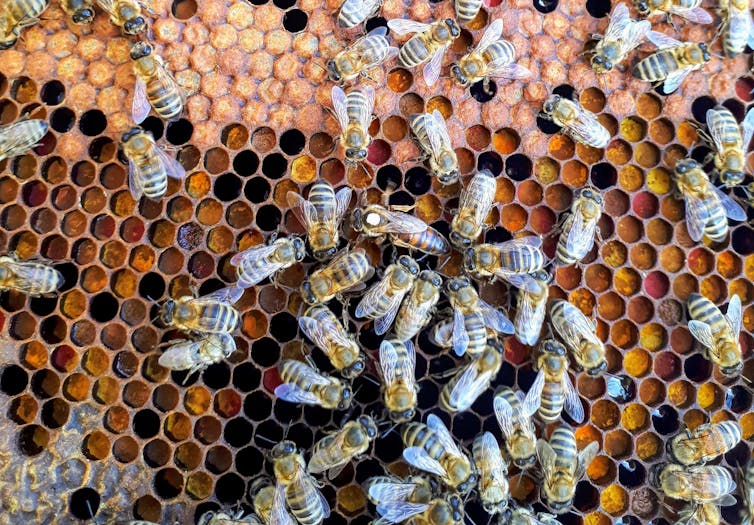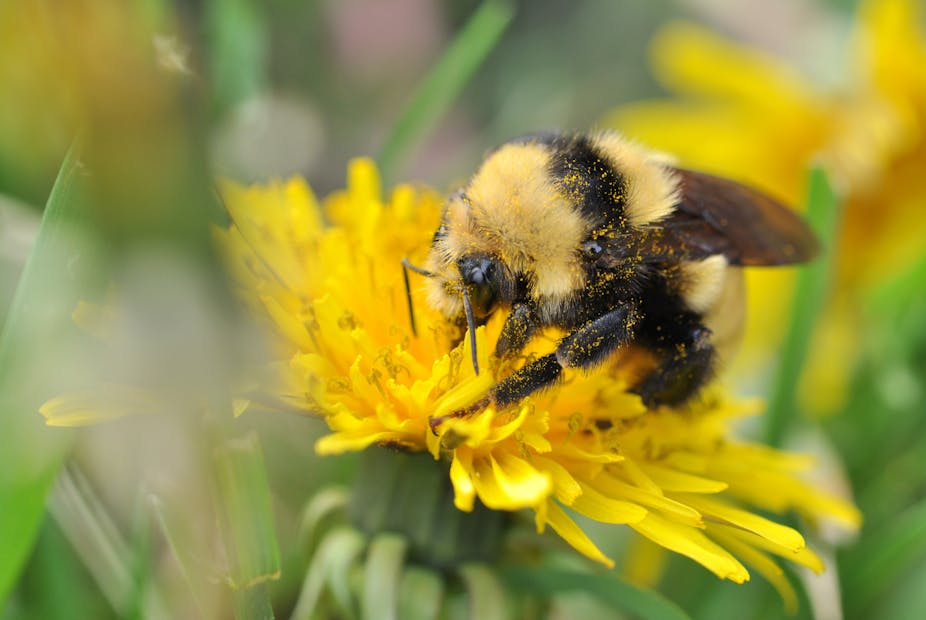The first days of spring – brighter and warmer – are a biological trigger for female bees to wake up from hibernation and begin to build future colonies.
These enormous bees, sometimes two to three times larger than a worker bee, are vital to our ecosystem and carry all the genetic material necessary for an entire generation of bees inside their bodies.
If you are lucky, you might see these big bees bumble through spring blossoms in search of food and a new home. Be careful not to disturb them. Killing a few bees during the summer may not have much impact. But the death of a single female bee, ready to reproduce in early spring, could wipe out an entire colony and erase the important services that her offspring would provide – pollinating flowers in gardens, parks, farms and meadows.
My research explores the foraging behavior of bees. I spend a lot of time in public parks and gardens in Seattle observing bees collecting pollen. I analyze which plants bees have visited and why. In early spring, I sometimes have the privilege of observing female bees as they search for a new home and visit plants to collect nectar for energy in flight. Bees accomplish their reproductive work in both simple and mysterious ways.

The wild social bee colony
Female bees are essential to the survival of all bee colonies, but each species is unique. Bees native to the United States lead different lives from one another depending on whether they are social bees or solitary bees.
Female social bees first begin looking for a new nesting spot – a hole in a tree, an abandoned rat’s nest, an empty mouse burrow – to lay hundreds of offspring to build a colony. At the same time, they collect pollen and nectar to feed the newly hatched bees. Social bee colonies can contain thousands of bees, each performing a different task to keep the colony healthy and safe.
Only the queen bee is fertile and correctly called “queen” if she belongs to a species where adult females live together and cooperate in some way. An estimated 10% of all bee species – of which there are more than 20,000 worldwide – are considered social bees with a queen in charge.
All the female bees laid by a social queen bee are sterile, keeping the queen in control and preserving the hierarchy of the hive. The sterile females and males perform low-level work like collecting food and caring for offspring.

Social queen bees are easily identified because they tend to be active early in the season and are often noticeably larger than most of their offspring. Queen bees can lay hundreds to thousands of eggs over the course of the summer. In the fall, a new queen bee is laid. The remainder of the colony dies off, and the queen overwinters alone, carrying all the genetic material to start a new population the following spring.
Solitary bees and their habits
Unlike social bees that live and work together with a single fertile female queen, solitary bees live alone, and all female solitary bees are fertile. Instead of building colonies, female solitary bees emerge in spring and mate with male solitary bees, then find a place to nest, such as a woodpecker hole, the siding of your house or a hole in the ground.
Female solitary bees create segmented nests for each individual offspring. They collect pollen from flowers and build a ball called a pollen provision inside each segment, anywhere from the size of a lentil to a large pea. Female solitary bees lay a single egg in each segment of the nest that contains a pollen provision, then die off. Solitary bees pollinate a huge number of flowering plants in the process of collecting food for their offspring. The offspring overwinter and emerge to continue the cycle the next spring.

What about honey bees?
A well-known social bee that provides pollination services is the non-native honey bee, a species that lives in man-made hives designed to easily transport bees and harvest honey. Honey bees are technically native to Europe, but have been domesticated by humans for thousands of years. Unlike native social bees that die off in the fall, honey bees hibernate during the winter inside their hives.
When a queen honey bee grows old after two to three years, offspring are designated as future queens and fed a highly nutritious diet of royal jelly – a mixture of nectar and pollen. The young queen is raised by her sisters until she reaches maturity. Then she leaves the nest to begin laying offspring and building a colony of her own. The honey bee colony continues to survive, cycling through generation after generation.
Building ecosystem resilience for bees
Female bees, responsible for future bee populations, face risks early in the season with limited flowers to visit for energy and a decline in nesting sites in more developed areas.
It’s best to provide female bees with many early spring flowers – they rely on nectar from flowers to fuel their search for a nesting spot. Planting early flowering plants such as willow, poplar, cherry trees and other spring blooms provides nectar for queen bees.
Garden restoration benefits all bees by fostering nesting sites for social and solitary bees. Nesting sites boost bee populations, pollinating native plants and boosting production in our backyard gardens and community gardens.
How can you help these amazing bees? Simply let them be. If it’s spring and a big bee is too close for comfort, move calmly out of the way and admire her from afar. Female bees, looking for a home, are usually too preoccupied with their search to sting you.
[You’re smart and curious about the world. So are The Conversation’s authors and editors. You can read us daily by subscribing to our newsletter.]

